Improving the Retrieval of Cloudy Atmospheric Profiles from Brightness Temperatures Observed with a Ground-Based Microwave Radiometer
Abstract
1. Introduction
2. Theory and Methodology
2.1. Theory for the Remote Sensing of Cloudy Atmospheres
2.2. Method to Estimate Cloud Water Concentration and Cloud Thickness
2.3. Algorithm for Atmospheric Temperature and Humidity Profile Inversion in Cloudy Conditions
2.4. Verification of the Cloud Correction
3. Data
4. Results
4.1. Statistical Comparison of the Errors in the Retrieved Profiles
4.2. Cases Comparison of the Retrieved Profiles with the RAOB
4.3. Performance under the Different Cloud Types
5. Conclusions and Suggestions
Author Contributions
Funding
Institutional Review Board Statement
Informed Consent Statement
Data Availability Statement
Acknowledgments
Conflicts of Interest
References
- Liang, L.; Li, X.; Zheng, F. Spatio-Temporal Analysis of Ice Sheet Snowmelt in Antarctica and Greenland Using Micro-wave Radiometer Data. Remote Sens. 2019, 11, 1838. [Google Scholar] [CrossRef]
- Gonzalez, S.; Bech, J.; Udina, M.; Codina, B.; Paci, A.; Trapero, L. Decoupling between Precipitation Processes and Mountain Wave Induced Circulations Observed with a Vertically Pointing K-Band Doppler Radar. Remote Sens. 2019, 11, 1034. [Google Scholar] [CrossRef]
- Liu, L.; Ruan, Z.; Zheng, J.; Gao, W. Comparing and Merging Observation Data from Ka-Band Cloud Radar, C-Band Frequency-Modulated Continuous Wave Radar and Ceilometer Systems. Remote Sens. 2017, 9, 1282. [Google Scholar] [CrossRef]
- Ware, R.; Carpenter, R.; Güldner, J.; Liljegren, J.; Nehrkorn, T.; Solheim, F.; Vandenberghe, F. A multichannel radiometric profiler of temperature, humidity, and cloud liquid. Radio Sci. 2003, 38, 8079. [Google Scholar] [CrossRef]
- Won, H.Y.; Kim, Y.H.; Lee, H.S. An application of brightness temperature received from a ground-based microwave radiometer to estimation of precipitation occurrences and rainfall intensity. Asia-Pac. J. Atmos. Sci. 2009, 45, 55–69. [Google Scholar]
- Barrere, C.A.; Eilts, M.; Johnson, J.; Fritchie, R.; Spencer, P.; Shaw, B.; Li, Y.; Ladwig, W.; Schudalla, R.; Mitchell, D. An Aviation Weather Decision Support System (AWDSS) for the Dubai International Airport. In Proceedings of the 13th Conference on Aviation, Range, and Aer-ospace Meteorology, New Oeleans, LA, USA, 20–24 January 2008; pp. 20–24. Available online: https://www.researchgate.net/publication/228958651_An_Aviation_Weather_Decision_Support_System_AWDSS_for_the_Dubai_International_Airport (accessed on 24 January 2019).
- Raju, C.S.; Renju, R.; Antony, T.; Mathew, N.; Moorthy, K.K. Microwave Radiometric Observation of a Waterspout Over Coastal Arabian Sea. IEEE Geosci. Remote Sens. Lett. 2013, 10, 1075–1079. [Google Scholar] [CrossRef]
- Gültepe, I.; Kuhn, T.; Pavolonis, M.; Calvert, C.; Gurka, J.; Heymsfield, A.J.; Liu, P.S.K.; Zhou, B.; Ware, R.; Ferrier, B.; et al. Ice Fog in Arctic During FRAM–Ice Fog Project: Aviation and Nowcasting Applications. Bull. Am. Meteorol. Soc. 2014, 95, 211–226. [Google Scholar] [CrossRef]
- Pan, Y.; Zhang, S.; Li, Q.; Ma, L.; Jiang, S.; Lei, L.; Lyu, W.; Wang, Z. Analysis of convective instability data derived from a ground-based microwave radiometer before triggering operations for artificial lightning. Atmos. Res. 2020, 243, 105005. [Google Scholar] [CrossRef]
- Li, J.; Guo, L.X.; Lin, L.K.; Zhao, Y.; Zhao, Z.; Shu, T.; Han, H. A Dual-Frequency Method of Eliminating Liquid Water Ra-diation to Remotely Sense Cloudy Atmosphere by Ground-Based Microwave Radiometer. Prog. Electromagn. Res. 2013, 138, 629–645. [Google Scholar] [CrossRef][Green Version]
- d’Auria, G.; Marzano, F.S.; Pierdicca, N.; Nossai, R.P.; Basili, P.; Ciotti, P. Remotely sensing cloud properties from micro-wave radiometric observations by using a modeled cloud database. Radio Sci. 1998, 33, 369–392. [Google Scholar] [CrossRef]
- Zhu, Y.J.; Hu, C.D.; Zhen, J.M.; Zhao, B.L. The Role of Microwave Radiometer in Weather Modification Research. Acta Sci. Nat. PKU 1994, 30, 597–606. [Google Scholar]
- Guo, L.J.; Guo, X.L. Verification study of the atmospheric temperature and humidity profiles retrieved from the ground-based multi-channels microwave radiometer for persistent foggy weather events in northern China. Acta Meteorol. Sin. 2015, 73, 368–381. (In Chinese) [Google Scholar]
- Heggli, M.; Rauber, R.M.; Snider, J.B. Field Evaluation of a Dual-Channel Microwave Radiometer Designed for Measurements of Integrated Water Vapor and Cloud Liquid Water in the Atmosphere. J. Atmos. Ocean. Technol. 1987, 4, 204–213. [Google Scholar] [CrossRef][Green Version]
- Revercomb, H.E.; Turner, D.D.; Tobin, D.C.; Splitt, M.E. The Arm Program’s Water Vapor Intensive Observation Peri-ods. Bull. Am. Meteorol. Soc. 2003, 84, 217–236. [Google Scholar] [CrossRef]
- Cadeddu, M.P.; Liljegren, J.C.; Turner, D.D. The Atmospheric Radiation Measurement (ARM) program network of mi-crowave radiometers: Instrumentation, data, and retrievals. J. Atmos. Ocean. Technol. 2013, 29, 1182–1201. [Google Scholar]
- Cimini, D.; De Angelis, F.; Dupont, J.-C.; Pal, S.N.; Haeffelin, M. Mixing layer height retrievals by multichannel microwave radiometer observations. Atmos. Meas. Tech. 2013, 6, 2941–2951. [Google Scholar] [CrossRef]
- Li, Q.; Hu, F.C.; Chu, Y.L.; Wang, Z.H.; Huang, J.S.; Wang, Y. A Consistency Analysis and Correction of the Brightness Temperature Data Observed with a Ground-based Microwave Radiometer in Beijing. Remote Sens. Technol. Appl. 2014, 29, 547–556. (In Chinese) [Google Scholar]
- Wang, Z.H.; Li, Q.; Chu, Y.L.; Zhu, Y.Y. Environmental Thermal Radiation Interference on Atmospheric Brightness Temperature Measurement with Ground-based K-band Microwave Radiometer. J. Appl. Meter. Sci. 2014, 25, 711–721. (In Chinese) [Google Scholar]
- Li, Q.; Wei, M.; Wang, Z.H.; Chu, Y.L.; Ma, L.N. Evaluation and Correction of Ground-Based Microwave Radiometer Ob-servations Based on NCEP-FNL Data. Atmos. Clim. Sci. 2019, 9, 229–242. [Google Scholar]
- Li, Q.; Wei, M.; Wang, Z.; Chu, Y. Evaluation and Improvement of the Quality of Ground-Based Microwave Radiometer Clear-Sky Data. Atmosphere 2021, 12, 435. [Google Scholar] [CrossRef]
- Hu, S.Z.; Ma, S.Q.; Ta, F.; Qin, Y.; Guo, W.; Wen, X.G. Ground based Dual band Cloud Observing System and Its Compar-ative Experiments. J. Appl. Meteorol. Sci. 2012, 23, 441–450. (In Chinese) [Google Scholar]
- Hewison, T.J. 1D-VAR retrieval of temperature and humidity profiles from a ground-based microwave radiometer. IEEE Trans. Geosci. Remote 2007, 45, 2163–2168. [Google Scholar] [CrossRef]
- Knupp, K.R.; Coleman, T.; Phillips, D. Ground-based passive microwave profiling during dynamic weather condi-tions. J. Atmos. Ocean. Technol. 2009, 26, 1057–1073. [Google Scholar] [CrossRef]
- Che, Y.; Ma, S.; Xing, F.; Li, S.; Dai, Y. An improvement of the retrieval of temperature and relative humidity profiles from a combination of active and passive remote sensing. Meteorol. Atmos. Phys. 2019, 131, 681–695. [Google Scholar] [CrossRef]
- Zhang, X.; Wang, Z.; Mao, J.; Wang, Z.; Zhang, G.; Tao, F. Experiments on improving temperature and humidity profile retrieval for ground-based microwave radiometer. J. Appl. Meteor. Sci. 2020, 31, 385–396. (In Chinese) [Google Scholar]
- Jiang, J.H.; Yue, Q.; Su, H.; Kangaslahti, P.; Lebsock, M.; Reising, S.; Schoeberl, M.; Wu, L.; Herman, R.L. Simulation of Remote Sensing of Clouds and Humidity From Space Using a Combined Platform of Radar and Multifrequency Microwave Radiometers. Earth Space Sci. 2019, 6, 1234–1243. [Google Scholar] [CrossRef]
- Stankov, B.B. Ground- and Space-Based Temperature and Humidity Retrievals: Statistical Evaluation. J. Appl. Meteorol. 1996, 35, 444–463. [Google Scholar] [CrossRef]
- Bianco, L.; Cimini, D.; Marzano, F.S.; Ware, R. Combining Microwave Radiometer and Wind Profiler Radar Measurements for High-Resolution Atmospheric Humidity Profiling. J. Atmos. Ocean. Technol. 2005, 22, 949–965. [Google Scholar] [CrossRef][Green Version]
- Klaus, V.; Bianco, L.; Gaffard, C.; Matabuena, M.; Hewison, T. Combining UHF radar wind profiler and microwave radiometer for the estimation of atmospheric humidity profiles. Meteorol. Z. 2006, 15, 87–97. [Google Scholar] [CrossRef]
- Barrera-Verdejo, M.; Crewell, S.; Löhnert, U.; Orlandi, E.; Di Girolamo, P. Ground-based lidar and microwave radiometry synergy for high vertical resolution absolute humidity profiling. Atmos. Meas. Tech. 2016, 9, 4013–4028. [Google Scholar] [CrossRef]
- Han, Y.; Westwater, E.R. Remote Sensing of Tropospheric Water Vapor and Cloud Liquid Water by Integrated Ground-Based Sensors. J. Atmos. Ocean. Technol. 1995, 12, 1050–1059. [Google Scholar] [CrossRef][Green Version]
- Westwater, E.R.; Zhenhui, W.; Grody, N.C.; McMillin, L.M. Remote Sensing of Temperature Profiles from a Combination of Observations from the Satellite-Based Microwave Sounding Unit and the Ground-Based Profiler. J. Atmos. Ocean. Technol. 1985, 2, 97–109. [Google Scholar] [CrossRef][Green Version]
- Zhang, P.C.; Wang, Z.H. Fundamentals of Atmospheric Microwave Remote Sensing, 1st ed.; Meteorological Press: Beijing, China, 1995; pp. 306–307. (In Chinese) [Google Scholar]
- Wei, C.; Lin, H.; Zou, S.X.; Xuan, Y.J. Microwave remote-sensing of atmospheric column water vapor and liquid water content of cloud over sea. J. Atmos. Sci. 1989, 13, 101–107. (In Chinese) [Google Scholar]
- Resteghini, L.; Capsoni, C.; Luini, L.; Nebuloni, R. An Attempt to Classify the Types of Clouds by a Dual Frequency Mi-Crowave Radiometer. In Proceedings of the IEEE 13th Specialist Meeting on Microwave Radiometry and Remote Sensing of the Environment (MicroRad), Pasadena, CA, USA, 24–27 March 2014; pp. 90–93. Available online: https://ieeexplore_ieee.gg363.site/abstract/document/6878915 (accessed on 16 May 2021).
- Erkelens, J.; Russchenberg, H.; Jongen, S.; Herben, M. Combining radar and microwave radiometer for cloud liquid water retrieval. In Proceedings of the IEEE 28th European Microwave Conference, Amsterdam, The Netherlands, 5–9 October 1998; pp. 67–72. [Google Scholar]
- Karstens, U.; Simmer, C.; Ruprecht, E. Remote sensing of cloud liquid water. Theor. Appl. Clim. 1994, 54, 157–171. [Google Scholar] [CrossRef]
- Hahn, J.; Warren, G.; London, J.; Chervin, M.; Jenne, R. Atlas of simultaneous occurrence of different cloud types over the ocean. Atmospheric Analysis and Prediction Division. Natl. Cent. Atmos. Res. 1982, 14–15. [Google Scholar] [CrossRef]
- Karmakar, P.K.; Maiti, M.; Calheiros, A.J.P.; Angelis, C.F.; Machado, L.A.T.; Da Costa, S.S. Ground-based single-frequency microwave radiometric measurement of water vapour. Int. J. Remote Sens. 2011, 32, 8629–8639. [Google Scholar] [CrossRef]
- Gentemann, C.L.; Meissner, T.; Wentz, F.J. Accuracy of Satellite Sea Surface Temperatures at 7 and 11 GHz. IEEE Trans. Geosci. Remote Sens. 2010, 48, 1009–1018. [Google Scholar] [CrossRef]
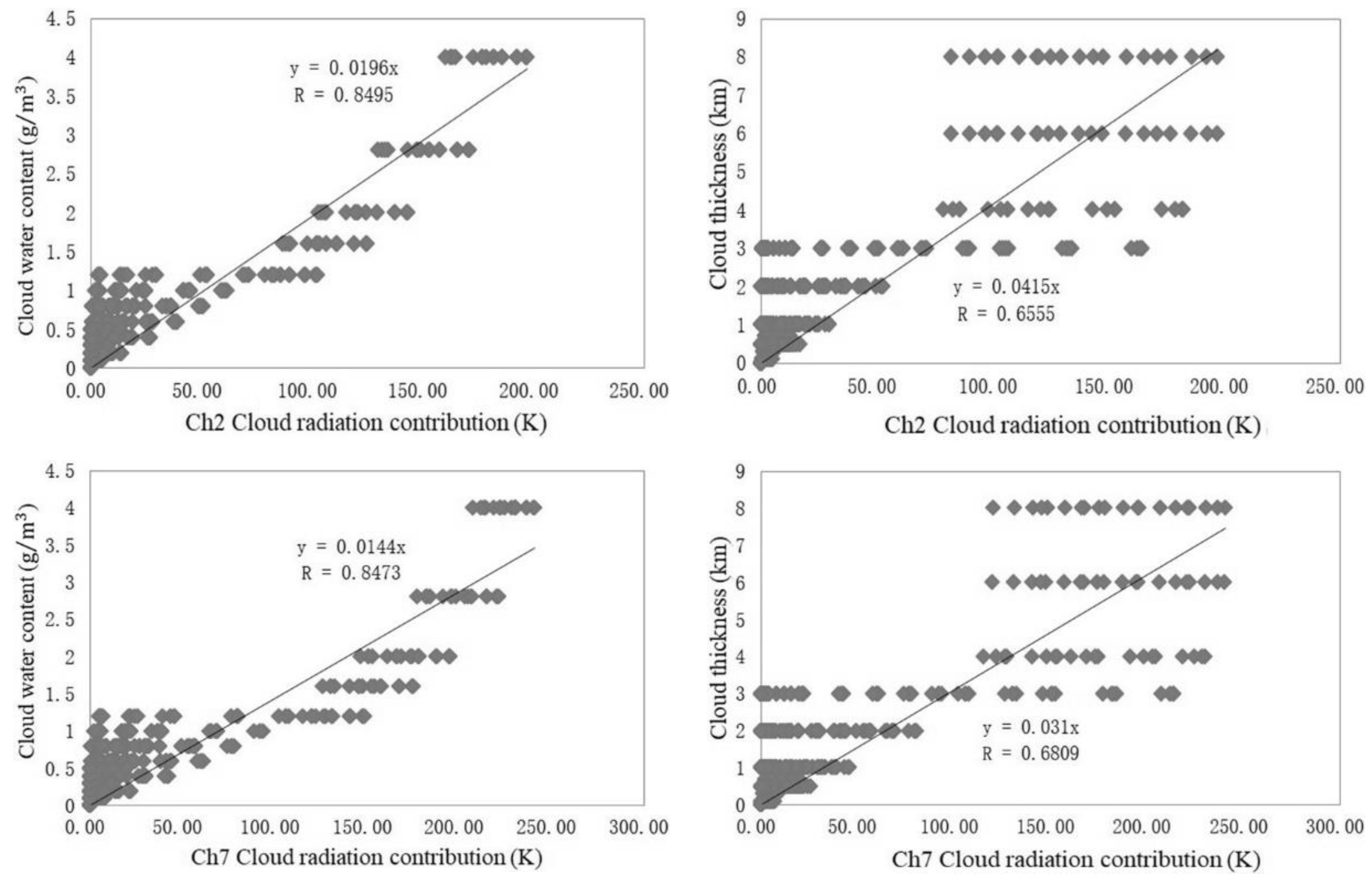
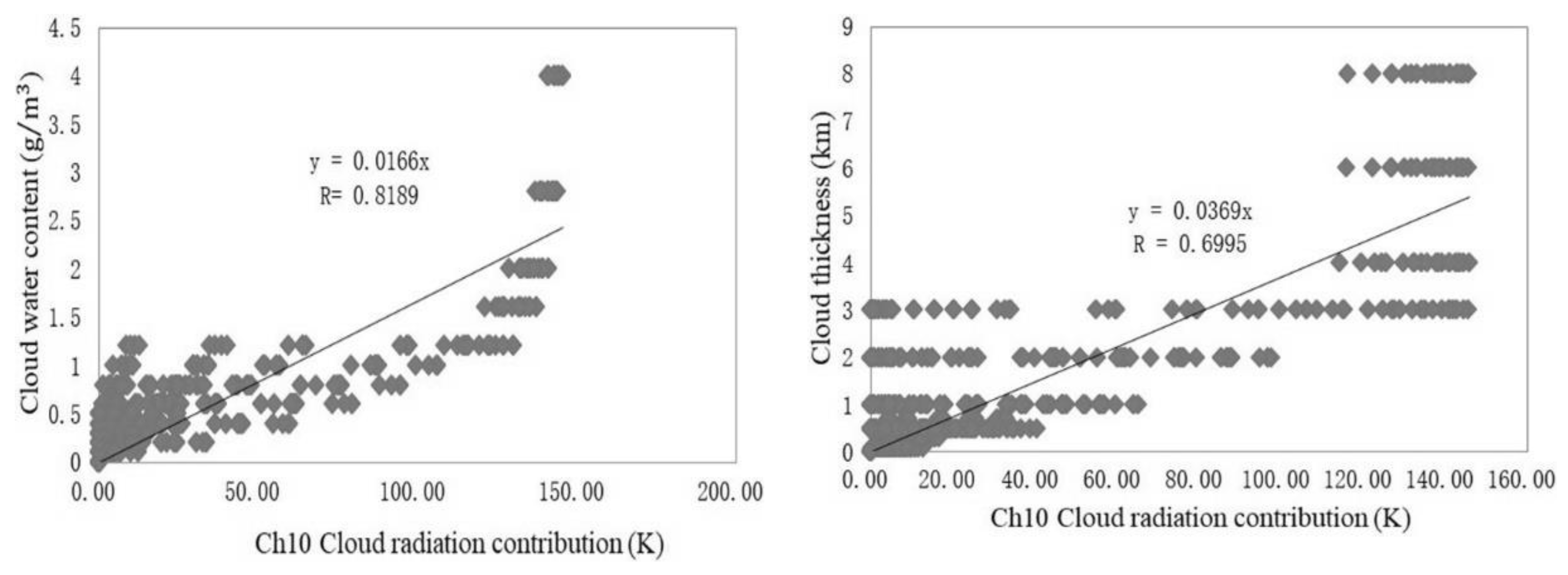
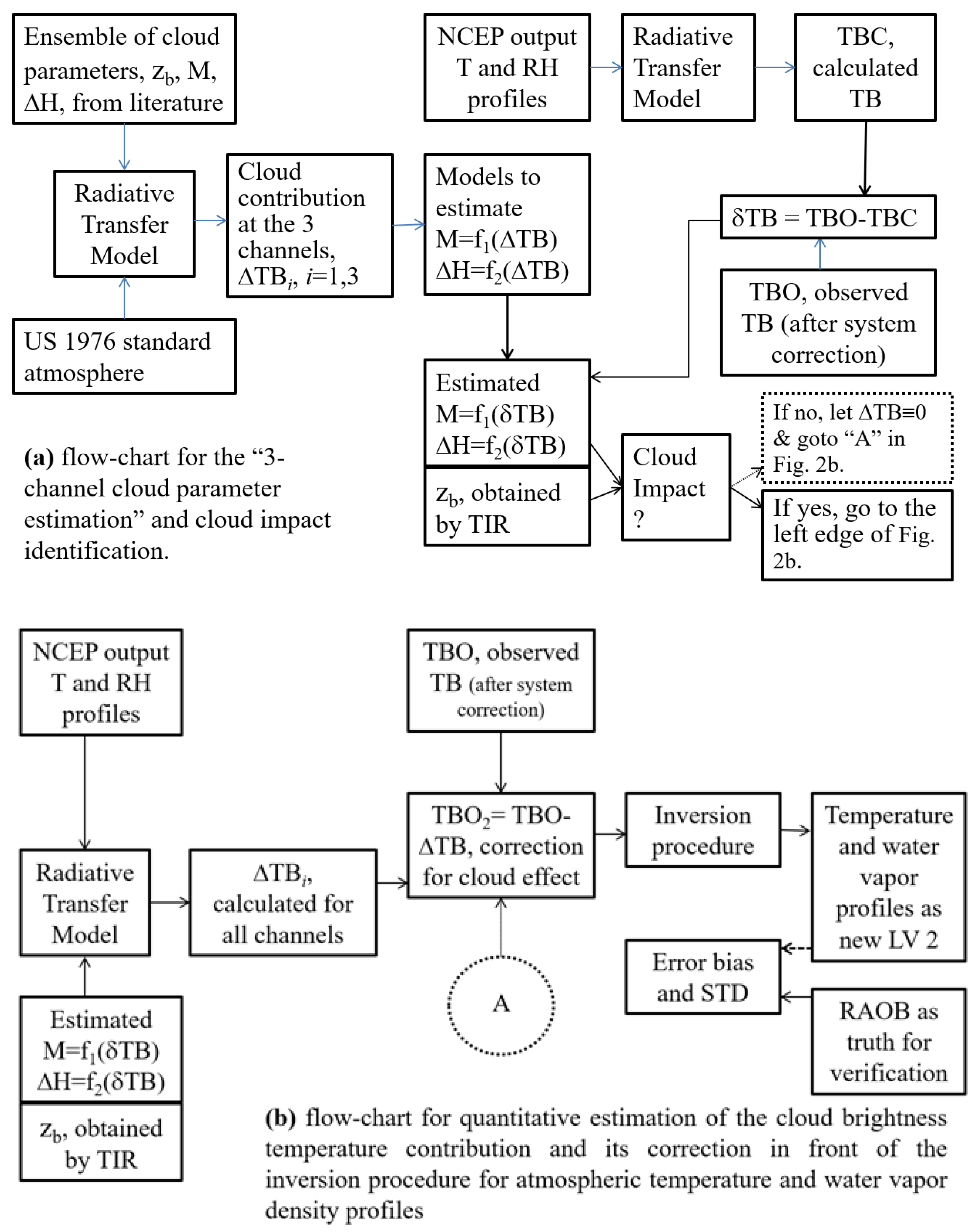
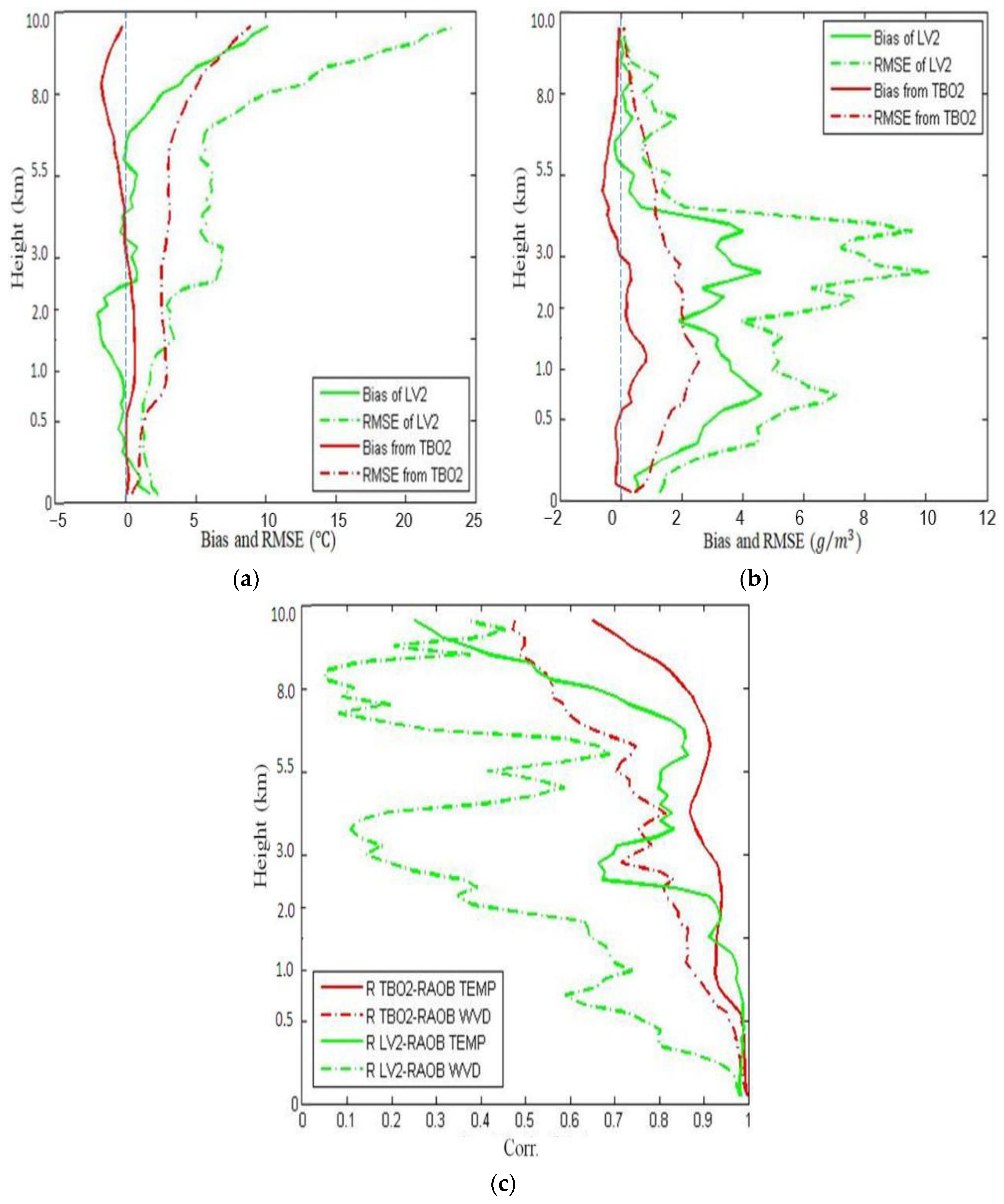
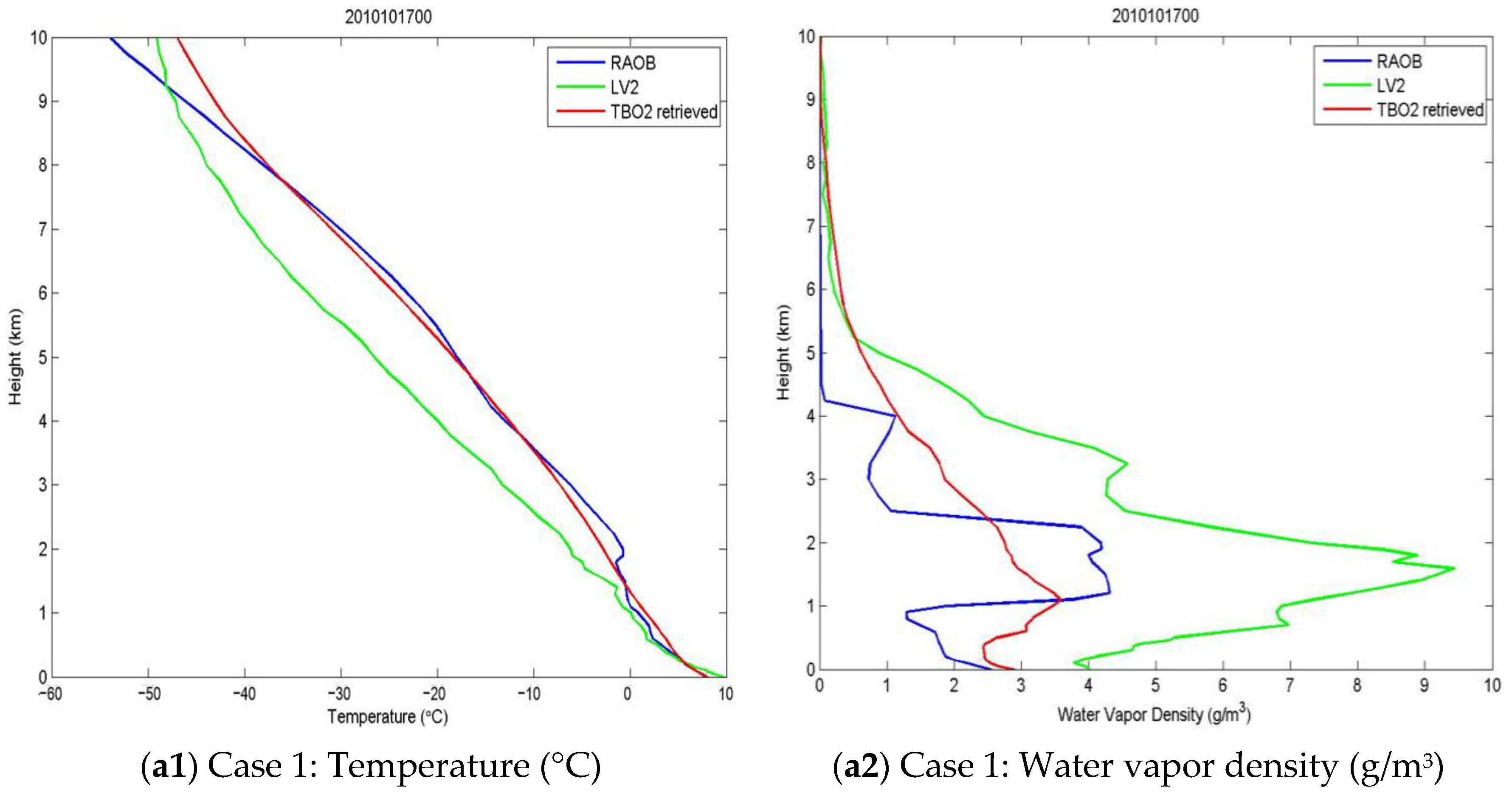
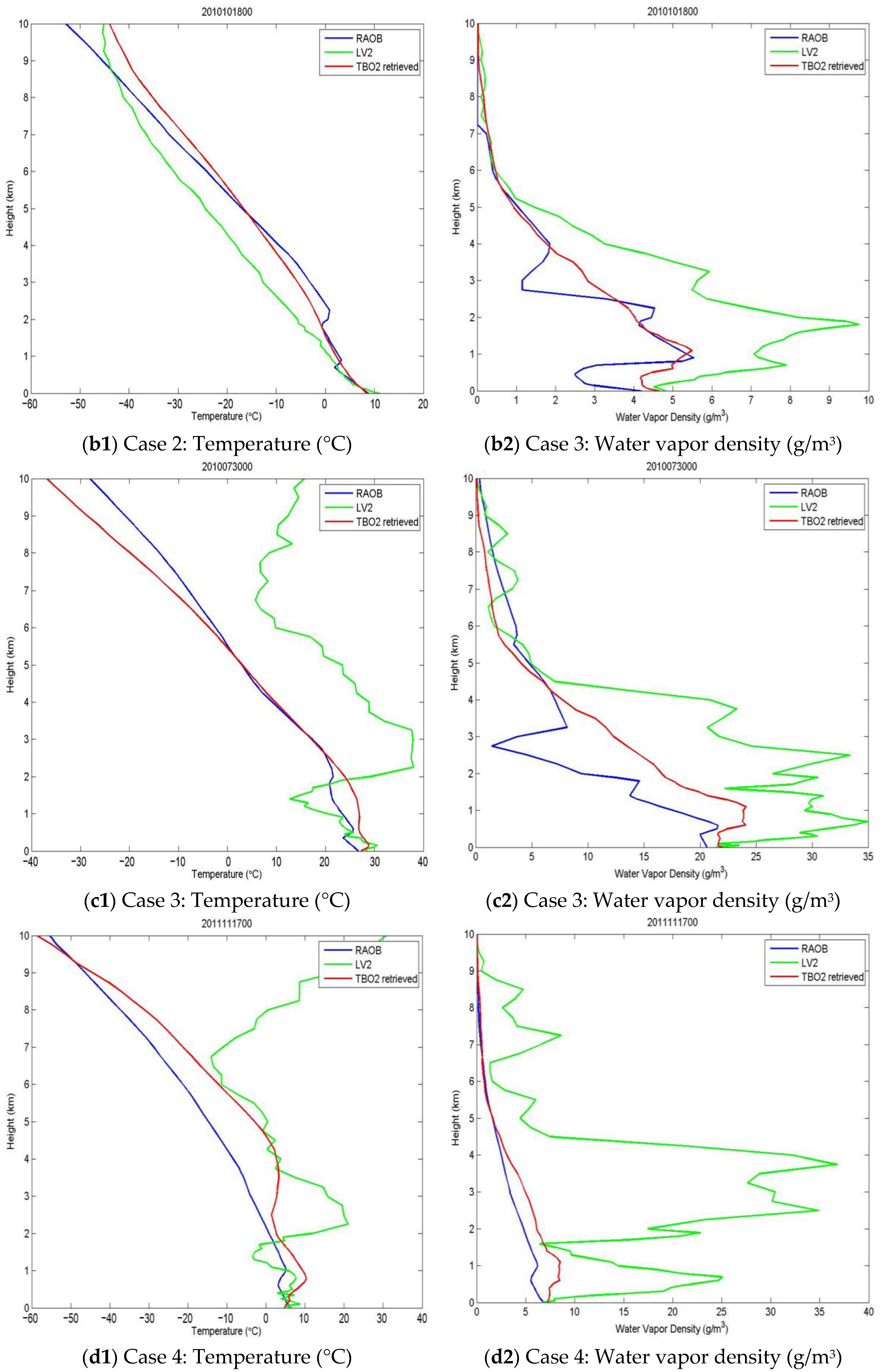
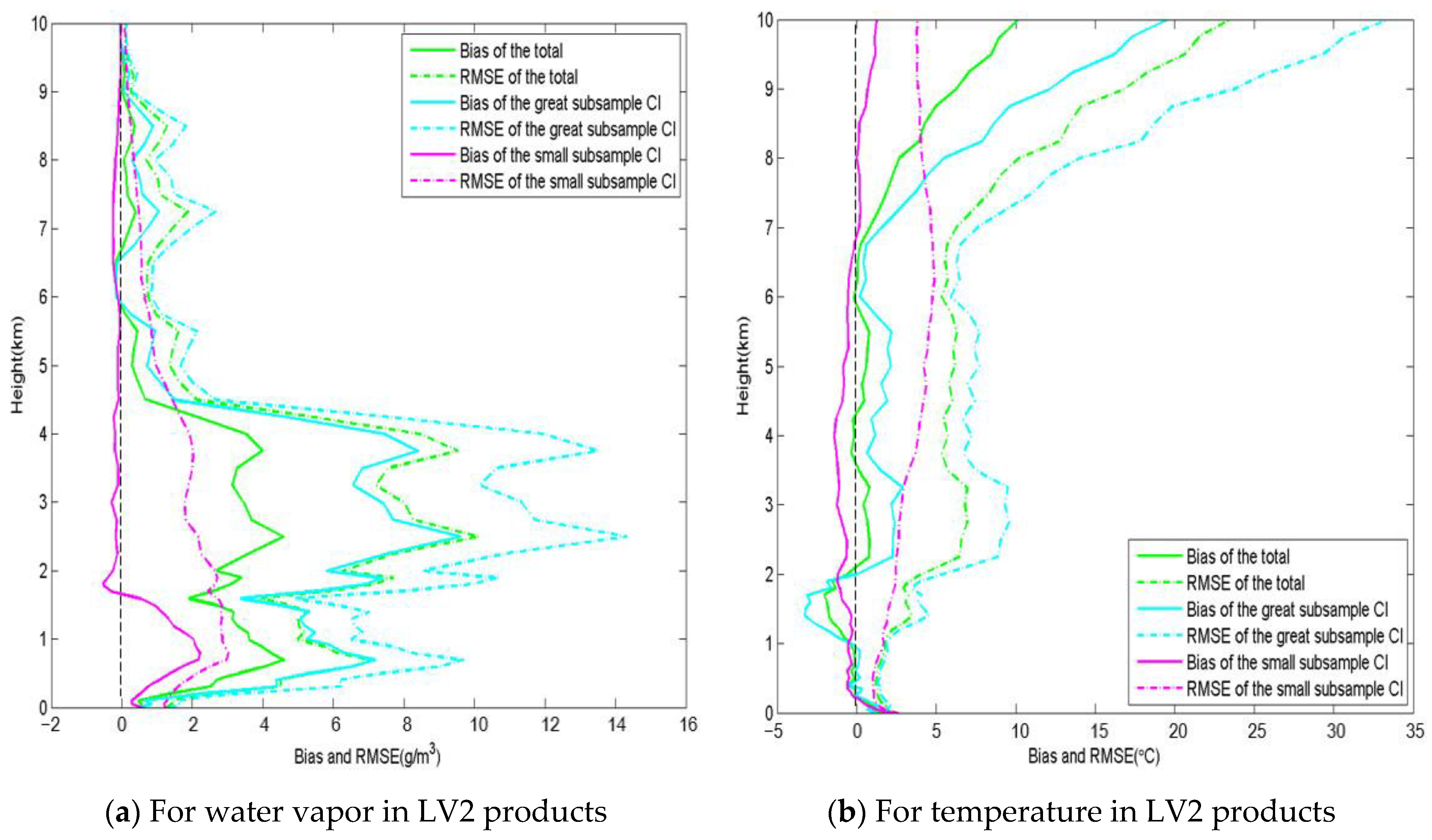
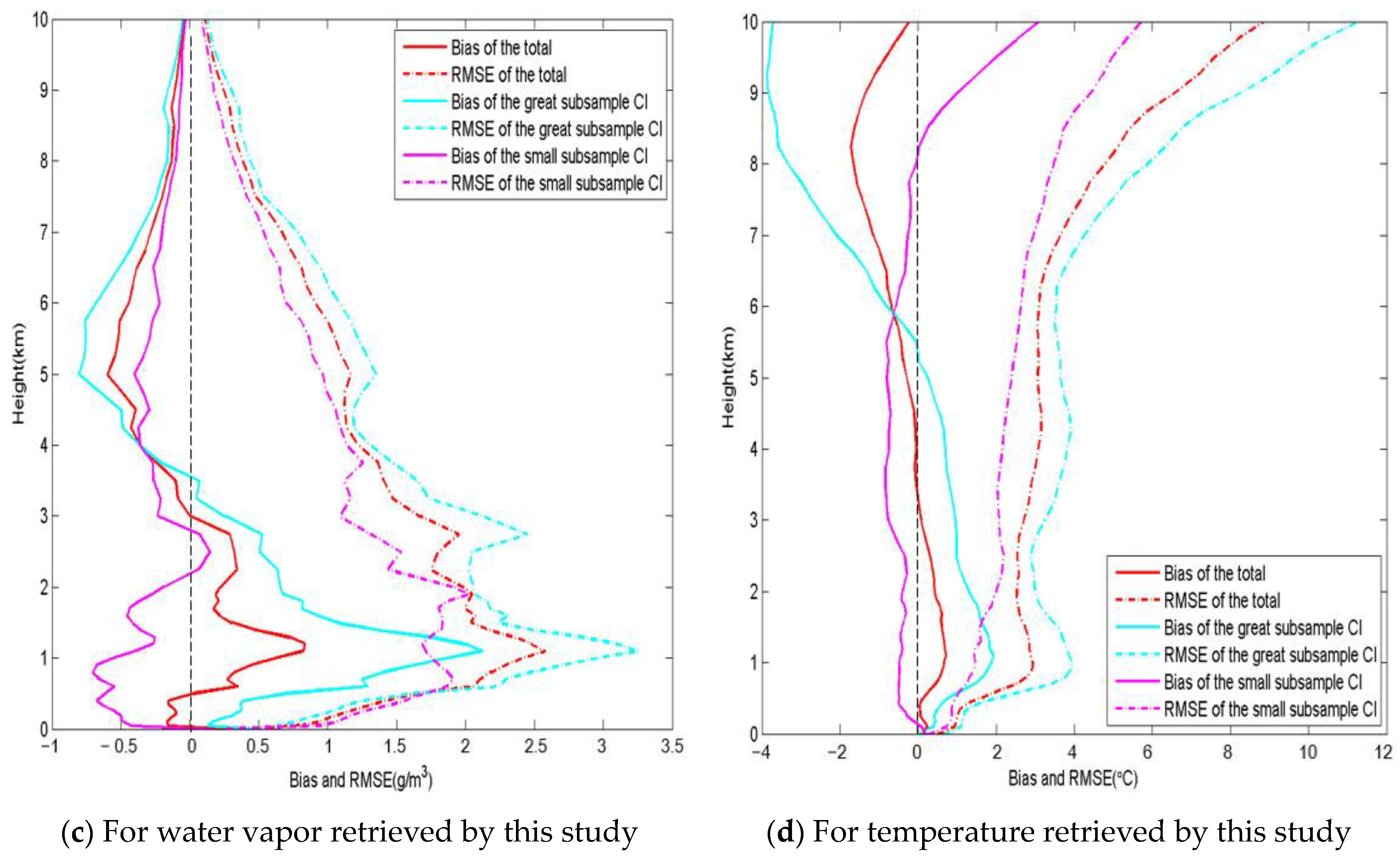
| Cloud Types | Cloud Base Height | Cloud Thickness | Cloud Water Concentration | Total Number of Combinations | Cloud Impact Index (min, max) |
|---|---|---|---|---|---|
| Cumulus | 500, 1000, 1500, 2000 | 100, 500, 1000, 2000 | 0.4, 0.6, 0.8, 1.0, 1.2 | 80 | 0.0200, 4.8 |
| Cumulonimbus | 500, 1000, 1500, 2000 | 3000, 4000, 6000, 8000 | 1.2, 1.6, 2.0, 2.8, 4.0 | 80 | 1.8000, 64 |
| Stratocumulus | 500, 1000, 2000, 2500 | 100, 500, 1000, 2000 | 0.2, 0.4, 0.6, 0.8, 1.0 | 80 | 0.0080, 4 |
| Stratus | 50, 200, 400, 800 | 100, 300, 500, 700 | 0.1, 0.2, 0.4, 0.6, 0.8 | 80 | 0.0125, 11.2 |
| Nimbostratus | 500, 1000, 1500, 2000 | 500, 1000, 2000, 3000 | 0.2, 0.4, 0.6, 0.8, 1.0 | 80 | 0.0500, 6 |
| Altostratus | 2000, 3000, 4000, 6000 | 100, 500, 1000, 2000 | 0.1, 0.2, 0.4, 0.6, 0.8 | 80 | 0.0017, 0.8 |
| Altocumulus | 2000, 3000, 4000, 6000 | 100, 500, 1000, 2000 | 0.1, 0.2, 0.4, 0.6, 0.8 | 80 | 0.0017, 0.8 |
| Cirrus | 4500, 6000, 8000, 10,000 | 500, 1000, 2000, 3000 | 0.1, 0.2, 0.3, 0.4, 0.5 | 80 | 0.0050, 0.3 |
| Cirrostratus | 4500, 6000, 8000, 9000 | 500, 1000, 2000, 3000 | 0.1, 0.2, 0.3, 0.4, 0.5 | 80 | 0.0056, 0.3 |
| Cirrocumulus | 4500, 6000, 7000, 8000 | 500, 1000, 2000, 3000 | 0.1, 0.2, 0.3, 0.4, 0.5 | 80 | 0.0063, 0.3 |
| Channel Index | Frequency (GHz) | Channel Index | Frequency (GHz) |
|---|---|---|---|
| 1 | 22.23 | 2 | 22.50 |
| 3 | 23.03 | 4 | 23.83 |
| 5 | 25.00 | 6 | 26.23 |
| 7 | 28.00 | 8 | 30.00 |
| 9 | 51.20 | 10 | 51.76 |
| 11 | 52.28 | 12 | 52.80 |
| 13 | 53.34 | 14 | 53.85 |
| 15 | 54.40 | 16 | 54.94 |
| 17 | 55.50 | 18 | 56.02 |
| 19 | 56.66 | 20 | 57.29 |
| 21 | 57.96 | 22 | 58.80 |
Publisher’s Note: MDPI stays neutral with regard to jurisdictional claims in published maps and institutional affiliations. |
© 2021 by the authors. Licensee MDPI, Basel, Switzerland. This article is an open access article distributed under the terms and conditions of the Creative Commons Attribution (CC BY) license (https://creativecommons.org/licenses/by/4.0/).
Share and Cite
Li, Q.; Wei, M.; Wang, Z.; Jiang, S.; Chu, Y. Improving the Retrieval of Cloudy Atmospheric Profiles from Brightness Temperatures Observed with a Ground-Based Microwave Radiometer. Atmosphere 2021, 12, 648. https://doi.org/10.3390/atmos12050648
Li Q, Wei M, Wang Z, Jiang S, Chu Y. Improving the Retrieval of Cloudy Atmospheric Profiles from Brightness Temperatures Observed with a Ground-Based Microwave Radiometer. Atmosphere. 2021; 12(5):648. https://doi.org/10.3390/atmos12050648
Chicago/Turabian StyleLi, Qing, Ming Wei, Zhenhui Wang, Sulin Jiang, and Yanli Chu. 2021. "Improving the Retrieval of Cloudy Atmospheric Profiles from Brightness Temperatures Observed with a Ground-Based Microwave Radiometer" Atmosphere 12, no. 5: 648. https://doi.org/10.3390/atmos12050648
APA StyleLi, Q., Wei, M., Wang, Z., Jiang, S., & Chu, Y. (2021). Improving the Retrieval of Cloudy Atmospheric Profiles from Brightness Temperatures Observed with a Ground-Based Microwave Radiometer. Atmosphere, 12(5), 648. https://doi.org/10.3390/atmos12050648






